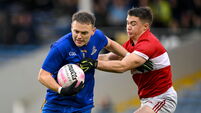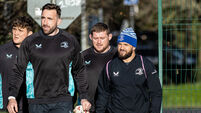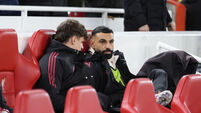When an American invasion cost GAA money and men

Davin was a fascinating individual and the diary is a thing of some beauty. It is marked to sell for between €4,000 and €6,000. The thing is, however, the diary has already been published: Davin included it in his lovely memoir Recollections of a Veteran Irish Athlete, which he published in 1938.
The plan for the tour – known to history as the American Invasion – was set out by Pat’s brother Maurice, the man who with Michael Cusack was central to the founding of the GAA and who wrote the first rules for hurling and Gaelic football.
On April 30, 1888, the second day of a two-day GAA meeting in the Mansion House in Dublin was drawing to a close, when Maurice Davin rose to address the delegates. He said that “for some time past he had been considering a project of sending a body of representative Gaels to America to represent the association there and to afford our brethren at the other side of the Atlantic an opportunity of witnessing our old Irish pastimes.”
The idea was that two teams of hurlers, to be selected from different parts of the country, as well as a number of the best all-round athletes that the country could produce, should be sent to America and Canada to give exhibitions in Gaelic pastimes, and also to compete with the athletes in America.
The aim of the tour was to establish the GAA in America and to establish an annual athletics and hurling contest between America and Ireland. Crucially, for the new association, it was estimated that the American Invasion – as the tour was immediately dubbed – would net the association a projected £5,000 of profit from gate receipts. The idea was well-received and the GAA decided to stage the tour later that year.
On September 16, 1888, 51 hurlers, athletes, and officials left on a nine-day voyage to America. Maurice Davin was the head of the party and Pat Davin was to compete as an athlete and hurler.
As they sailed away from Queenstown (now Cobh), aboard the SS Wisconsin, there were bands playing and massed crowds cheering on the quays. The first night on the boat was idyllic – dancing on the deck till late in the evening with Germans and Russians and Swedes.
And then came the storm.
The hurlers, coming as most of them did, from inland areas were extremely badly affected, most of them vomiting continuously.
At 1am, the ship was almost lost when it was hit by a massive wave. Passengers were thrown about the place and, Pat Davin later recalled, that most of the hurlers “remained up saying their prayers and expecting every minute to be their last”. Their state of mind was not improved by the sight of a small boat being driven around the sea with only the stump of its mast remaining.
Things did not improve immediately upon arrival when, at their first practice in Manhattan, one of the Irish athletes lost control of a hammer throw and did serious damage to a spectator.
Maurice Davin gave hammer-throwing exhibitions throughout the tour, though it is unclear whether it was he who hit the spectator.
The hurling exhibition matches drew huge praise in the local press and were reported as creating “a veritable hurricane of excitement and applause”. They also seemed to be anything but exhibitions. For example, in the match in the Manhattan Grounds, there were at least a dozen hurleys broken. Not long into the tour, the hurlers were running out of hurleys and had to get some made for them by the veteran Fenian, Bob Kelly. Unfortunately, the only wood available was hickory. The clash of the hickory did not have quite the same ring to it and in the first melee all the hurleys disintegrated into matchwood.
But the hurling matches were not just about sport.
In his diary of the tour, Pat Davin remembered three respectable old ladies with a hurley they had been given by one of the players. The sight of the hurley was so evocative of home, he wrote, that “each of them took it in turn and kissed it with reverence, while all three wept copiously”. The arrival of a team of GAA athletes was a massive moment for the Irish of Boston, New York, and Philadelphia. On their arrival in every city, the invaders were met by piped and brass bands and were paraded to their hotels. In Boston, they were dragged through the streets in carriages pulled by Irish emigrants.
And yet the tour was a financial disaster. Two bodies were then in dispute over who controlled American athletics. The GAA attempted to stay neutral but was hit by a boycott of sorts which limited the scope of the tour to just 15 exhibition hurling matches, while the athletes only competed on nine occasions.
As a result of heavy snow, the entire two-week additional invasion of Canada was cancelled. The athletics split, the boycott, and the bad weather all had a huge impact on attendances. In the middle of the tour, the Invaders ran out of money. Maurice Davin was forced to wire Michael Davitt, the Land League leader who was a patron of the GAA, to bail them out to the tune of more than £450.
It had been hoped to pay off Davitt with money earned in an end-of-tour exhibition. On the night before sailing for home, there was an indoor sports festival staged by way of a ‘send-off’ for the Irish athletes. A huge crowd, numbering several thousand, filled Madison Square Garden to overflowing. And yet, at the end of the meeting, the local American organisers presented the Irish Invaders with a bill for $75 which they claimed was the sum they had lost on the night.
This was, wrote Pat Davin, “a cruel and shameless trick”. Worse than the loss of money, though, was the loss of men. More than 20 of the original touring party of 51 remained permanently in America and several more returned to Ireland only to tidy up their affairs before going to live and work in America. Maurice Davin was deeply upset on the afternoon of October 31 when their ship sailed out of New York, waved off by several hundred Irish emigrants and the remnant of his own Invaders.
It all amounted, wrote Pat Davin, to a “very affecting sight… Most of them never set eyes on their native shores again.”
While the diary will be sold at auction on Saturday (it will surely draw huge interest), it can also be read for free at the National Library and other libraries and institutions which carry Recollections of a Veteran Irish Athlete.











